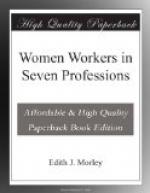Other advantages are a steadily progressing scale of salary, provided that efficient service is rendered; annual leave with pay; a reasonable working day—seven hours for the clerical force and the typists, and eight hours for the other classes; in most Departments payment is made for overtime; a pension on compulsory retirement after ten years’ service, except in the case of women retired on marriage, when a gratuity is given after six years’ service, amounting to one month’s salary for every year of service up to twelve years. A compassionate allowance is also given on the same basis for both sexes, in cases where an officer is compelled to retire through ill-health before completing ten years’ service. Sick pay is granted up to a maximum of six months on full pay and six months on half pay. The full period of leave is not, however, always allowed before retirement. It is given only at the discretion of the Department, if there is a chance of complete recovery; officers have no definite claim to it. Although these are distinct advantages to the staff, it must not be overlooked that it is essential for the State to offer some inducements of this kind, in order to obtain a staff more or less permanent who will regard their employment as a career. It is most important for the proper conduct of a Government office that the officials should have a lasting interest in their work, and a share in the successful administration of the Department.
Women Civil Servants are under the Superannuation Act of 1859 as regards their pensions, and receive an amount equal to one-sixtieth of their annual salary at retirement, for every year of service. Under the Courtney Scheme of 1909, the basis of calculation is one-eightieth instead of one-sixtieth, and the reduction in the pension is compensated by a cash payment at retirement, or, in the event of death occurring whilst in harness, a cash payment is made to the next-of-kin. Women secured their exclusion from the provisions of the latter scheme at their own request, as it was felt that the larger pension was of more value to them than the cash payment at death or retirement; moreover their pensions were already too small to admit of further diminution.
It is a general rule throughout the Service that a woman must retire on marriage; as already mentioned, a compensating-bonus is granted in respect of the loss of pension thereby sustained. A married woman has no definite claim to return to her employment, should she again desire to earn her own living, and only if widowed is she allowed, in certain circumstances, to return to the Service. Should any other misfortune overtake her, or should she for any other reason wish to become economically independent, she is not allowed to earn her living by means of her own profession of Civil Servant. This rule of the Service undoubtedly acts as a deterrent to marriage for, according to the statistics published, only about 3 per cent. of the




